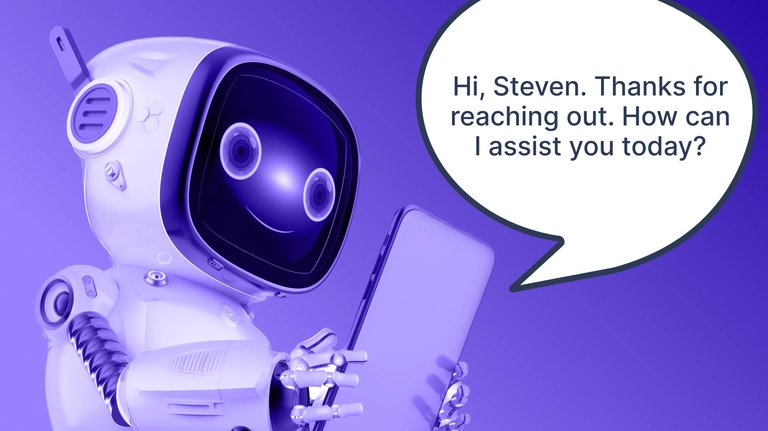
What is the best conversational AI? Chatbot vs. conversational AI
You may have met conversational AIs like chatbots and virtual assistants like Alexa. Let's explore their features, edges, examples, etc.
Talking to a computer seems like a far-fetched idea out of a sci-fi movie. Yet here we are in 2023, where that’s very much a reality. Known as conversational AI, this technology has made waves in the last year.
In this article, we’re taking a good look at what conversational AI is, how it works, its benefits, examples, how it compares to chatbots, and more.
Keep reading to learn all about it.
What is Conversational AI?
Conversational AI is a technology that enables machines (computers) to engage in human-like conversations. It allows computers to understand, process, and respond to human language in a natural and contextual manner.
This is possible through a mix of Natural Language Processing (NLP), machine learning, and other advanced technologies. Conversational AIs you might have already come across include chatbots, virtual assistant technology (think Alexa, Siri, Google Assistant, Cortana), and ChatGPT.
How conversational AI works
Conversational AI utilizes several advanced technologies to understand and process human-like speech or text. Here’s a quick overview of the main components:
Natural Language Processing (NLP.) This is the core technology that makes conversational AI possible. It consists of:
Natural Language Understanding (NLU.) This helps the system understand intent and context. It can extract entities (like dates or names) and understand sentiments or emotions.
Natural Language Generation (NLG.) This enables the system to craft coherent and relevant responses based on its understanding.
Dialog management. This component is in charge of the flow of the conversation. It ensures that the AI can go back and forth like a human would. It also helps the AI remember context from previous interactions and provide relevant responses based on the ongoing conversation.
Machine Learning (ML.) ML algorithms allow the system to learn from past interactions and improve. Oftentimes, this training is guided by humans. The more data, interactions, and feedback the system is exposed to, the better its responses become.
Integration with external systems. Depending on the use case of the Conversational AI, it might need to be integrated or have access to databases, systems, tools, etc. For example, a chatbot whose purpose is customer support might have access to your company documentation and product information.
To summarize, the way a Conversational AI works is by first receiving input from a user and processing it using NLP to understand the intent. It then puts together a response, either by generating it from scratch using NLG or by selecting a suitable pre-defined answer. This response is then relayed back to the user, completing the interaction and improving the customer experience.
Benefits of conversational AI
If we had to list all the benefits of conversational AI solutions, it might take us all day.
But here are the key advantages for businesses, consumers, and other various applications:
24/7 availability
Chatbots, personal assistants, and other tools like ChatGPT are available around the clock. Users can get assistance whenever they need it.
Cost efficiency
Although AIs are extremely expensive to train and deploy on a large scale, the marginal cost per each additional user is minimal. Therefore, end users like you and me can leverage this tool for free or just $20 in the case of the pro version of ChatGPT. It can also handle a large volume of queries simultaneously in the context of customer support, reducing the need for large support teams and therefore reducing operational costs.
Consistency
Conversational AI provides rule-based consistent responses, ensuring every user receives accurate and uniform information.
Scalability
As user interactions increase, conversational AI systems can easily scale to handle the additional traffic without compromising response time or quality.
Personalization
Advanced conversational AIs can remember past interactions and use this data to provide personalized experiences.
Multilingual support
Many AIs can communicate and answer questions in multiple languages, breaking down geographical and linguistic barriers in business and everyday life.
Error reduction
Unlike humans, who can occasionally provide incorrect information due to oversight or fatigue, a good conversational AI ensures more accurate responses.
Integration capabilities
Conversational AI tools can integrate with websites, CRMs and chatbots, to obtain real-time data and provide more comprehensive answers in each conversation flow.
Improved user experience
With instant responses and the ability to handle complex inputs, users often enjoy a better experience versus dealing with a person.
As you can see, conversational AIs have many benefits. These apply to both businesses and consumers and will only get better as the technology improves throughout the years.
Examples of conversational AI
Although we’ve already mentioned a few examples of conversational AI platforms, let’s take a closer look and divide them by their use-case.
Generative AI
ChatGPT. An advanced conversational model developed by OpenAI.
Bard. A conversational generative AI tool developed by Google.
Chatbots
Chatfuel. One of the largest no-code chatbot platforms in the world.
Intercom. A customer messaging platform that allows businesses to communicate with customers on their websites.
Drift. A conversational marketing platform designed to generate leads through chatbots.
Zendesk. A customer service software that includes a chatbot feature for support.
Virtual assistants
Alexa. Amazon’s flagship virtual assistant used in Amazon devices.
Siri. Apple’s virtual assistant integrated into its devices.
Google Assistant. Google’s virtual voice assistant found on Android devices and Google Home speakers.
Cortana. Microsoft’s virtual assistant integrated into Windows and other Microsoft devices.
Text-to-speech software
LOVO. An AI voiceover platform with many realistic voices.
Murf AI. A platform for creating AI voiceovers for videos.
Veed AI. A video editing software that includes text-to-speech functionality.
Natural Reader. A software that converts text to speech for a variety of applications.
What is the best conversational AI?
It can be incredibly hard to determine which conversational AI is best. They are constantly improving, and each has its strong points. However, right now, the best conversational AI seems to be ChatGPT. More specifically, GPT-4, the latest model OpenAI released.
What makes GPT-4 so good is the incredibly large dataset it was trained on, its high accuracy, ease of use, intelligence, and extra features like code interpreter and the ability to use plugins.
Other extremely powerful conversational AIs include Google’s Bard and Facebook’s LLaMA.
Conversational AI vs. chatbots — what are the differences?
Conversational AIs and chatbots are terms often used interchangeably. And there is indeed a lot of overlap between the two, but there are also a lot of differences.
Overlap
Both are designed to interact with humans in a conversational manner. They are used to automate tasks, answer queries, and provide information.
They both use NLP and deep learning to understand and respond to user inputs.
Both can be integrated with external systems and databases to provide more comprehensive and relevant responses.
They both aim to improve user experience by providing instant responses and being available 24/7.
Differences
Conversational AIs can often be more advanced than traditional chatbots. They use machine learning and other technologies to learn from past interactions and improve over time. This allows them to handle more complex queries and provide more accurate responses.
Conversational AIs like ChatGPT can also have additional features like code interpretation, image inputs, and plugins. Chatbots do not have those.
Conversational AIs can remember past interactions and use this data to provide personalized experiences. Traditional chatbots don’t normally have this capability.
There are regular chatbots that may have much less overlap with Conversational AI, and there also are AI-powered chatbots, such as Chatfuel, which have much more overlap. In our case, we’ve looked at the latter.
Ready to put conversational AI into action?
Experience the future of customer interactions with Chatfuel. Whether you’re a new startup or an established enterprise, our AI-powered chatbot platform is designed to elevate your customer support to the next level.
With Chatfuel, you can automate customer support, reduce response times, personalize user interactions, and even power multiple platforms (your website, Messenger, Instagram, and WhatsApp.)
And we’re powered by ChatGPT, the most powerful conversational AI out there.
Experience the benefits yourself — sign up for a free trial today.
